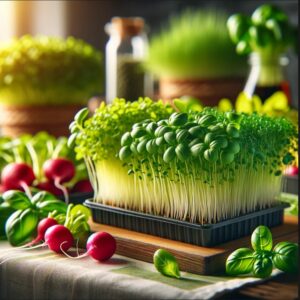Growing Microgreens – A Summary For Beginners
Growing Microgreens – A Summary For Beginners
The Basics of Microgreens
Microgreens have gained popularity among health enthusiasts and culinary experts alike due to their nutritional value and vibrant flavors. These tiny greens are essentially young vegetable plants, harvested shortly after the first true leaves have developed. They’re not only packed with vitamins and minerals but also add a beautiful aesthetic to dishes.

Benefits of Using LED Lights for Microgreens
Growing microgreens indoors under LED lights offers numerous advantages. LED technology has evolved to provide a spectrum of light that closely mimics natural sunlight, which is crucial for photosynthesis and the healthy growth of plants. LED lights generate less heat, reducing the risk of drying out the delicate greens. Additionally, they’re energy-efficient and have a long lifespan, making them an economic choice for indoor farming.
Growing microgreens indoors with LED lights provides a multitude of benefits that extend beyond basic plant growth. LED technology has made significant strides over the years, allowing indoor farmers and gardening enthusiasts to cultivate plants efficiently and effectively.
One of the primary advantages of using LED lights for microgreens is their ability to simulate the spectrum of natural sunlight. This spectrum is essential for photosynthesis, the process by which plants convert light into chemical energy. Unlike traditional lighting options, LED lights can be fine-tuned to emit specific wavelengths of light, which are optimal for the photosynthetic activity of microgreens. This targeted approach ensures that the plants absorb more light energy, leading to faster growth, higher yield, and improved nutritional content.
LED lights are known for their low heat emission, which is particularly beneficial for the cultivation of microgreens. These young plants are sensitive and can easily be damaged or dehydrated by excessive heat. With LEDs, the risk of overheating the plants is significantly reduced, allowing for closer placement of the lights to the plants. This proximity ensures that the microgreens receive an ample amount of light without the adverse effects of high temperatures.
Selecting the Right LED Light
Choosing an LED light for your microgreens involves considering factors such as light intensity, color spectrum, and duration of exposure. Light intensity impacts the growth rate and structural development of the plants; hence, it’s important to select an LED with adjustable intensity to cater to the different growth stages. A full-spectrum LED light is most beneficial, as it includes all the colors required for healthy plant growth, including blue and red, which are essential for leaf development and robust roots.
Selecting the ideal LED light for growing microgreens is a critical decision that can significantly influence the success of your indoor gardening venture. When choosing an LED light, it’s important to consider several key factors to ensure your microgreens thrive and reach their full potential.
Firstly, light intensity, measured in micromoles per square meter per second (µmol/m²/s), is crucial as it affects the growth rate and overall health of the microgreens. An LED light with adjustable intensity offers the flexibility to modify the light output to suit various growth stages, from germination to harvest. This adaptability helps in providing the right amount of light, preventing issues like legginess or stunted growth.
The color spectrum of the light is another vital factor. Microgreens respond differently to various wavelengths of light, which influence aspects such as growth rate, leaf color, and nutrient composition. A full-spectrum LED light, which includes a balance of cool (blue) and warm (red) wavelengths, simulates the natural sunlight conditions. Blue light promotes leafy growth and strong stems, while red light is essential for root development and flowering in later stages of a plant’s life cycle.
In addition to light intensity and spectrum, the duration of light exposure is also key. The photoperiod, or the amount of time the plants are exposed to light each day, needs to be controlled to mimic natural daylight cycles, which can vary depending on the specific needs of the microgreens you are growing.
By carefully selecting an LED light that offers the right intensity, spectrum, and control over the duration of exposure, you can create an optimal growing environment that encourages healthy, vigorous growth of your microgreens, enhancing their nutritional value and taste.
Setting Up Your Microgreens Growth Area
Your microgreens growing station can be as simple as a shelf with LED lights mounted above or a more sophisticated setup with automated controls for light and watering. Ensure that you have a flat surface where you can place your growing trays and that the LED lights are positioned about 6 to 12 inches above the plants. This distance ensures that the microgreens receive adequate light without the risk of leaf burn.
Planting and Caring for Your Microgreens
Start by selecting quality seeds and a growing medium such as soil or a soilless mix. After evenly spreading the seeds in your tray, lightly cover them with your medium or a thin layer of vermiculite. It’s important to keep the medium moist, but not waterlogged, to encourage germination. Once the seeds have sprouted, exposing them to your LED lights will kickstart the photosynthesis process. Regularly check moisture levels and keep the growing environment between 60-70°F for optimal growth.
Harvesting and Storing Your Microgreens
Microgreens are ready to harvest usually two to three weeks after planting, once they have developed their first true leaves. Use a sharp knife or scissors to cut the greens just above the soil line. After harvesting, rinse them gently and let them dry before storing. Microgreens are best consumed fresh but can be stored in a refrigerator for a few days, ideally in an air-tight container.
Cooking with Microgreens
Microgreens, with their delicate textures and vibrant flavors, have become a staple in kitchens, from professional settings to home cooking. These tiny greens can elevate even the simplest dishes with a burst of color and nutrition. If you’re a beginner or a home cook looking to incorporate microgreens into your meals, here are some common and easy ways to use them:
1. Salads: One of the most straightforward ways to use microgreens is by tossing them into salads. Their fresh, often peppery or sweet flavors can add a new dimension to your greens. Mix them with other salad leaves or use them as the primary ingredient. A simple dressing of olive oil, lemon juice, salt, and pepper can enhance their taste without overpowering their delicate flavor.
2. Sandwiches and Wraps: Elevate your sandwiches and wraps by adding a handful of microgreens. They introduce a fresh, crisp texture and a nutritional boost. Whether you’re making a classic turkey sandwich, a vegetable wrap, or a grilled cheese, microgreens can add a gourmet touch to these everyday meals.
3. Garnishes: Chefs often use microgreens as garnishes to add color and flavor to dishes. You can do the same at home to make your meals more visually appealing and tasty. Sprinkle microgreens on top of soups, stews, pizzas, or omelets just before serving.
4. Smoothies and Juices: For an extra dose of nutrients, add a handful of microgreens to your smoothies or juices. They blend well with fruits and other vegetables, boosting your drink’s vitamin and mineral content without compromising flavor.
5. As a Base for Appetizers: Microgreens can be a delicate and flavorful base for appetizers. Top them with slices of smoked salmon, a dollop of cream cheese, or a piece of grilled vegetable for a quick and elegant starter.
6. Incorporating into Hot Dishes: While microgreens are often used raw, they can also be gently wilted into hot dishes at the end of the cooking process. Add them to pastas, risottos, or stir-fries just before serving to retain their color and nutritional value.
Remember, microgreens are versatile and can be adapted to a wide range of cuisines and dishes. Experimenting is key—try different types of microgreens to discover which flavors you enjoy most. Whether you’re garnishing a dish, tossing them into a salad, or blending them into a smoothie, microgreens are a simple way to add a nutritional punch and a dash of color to your cooking.

Troubleshooting Common Issues
While LED lights offer many advantages, growers can sometimes encounter issues such as leggy plants or discoloration. If your microgreens are stretching excessively, it often means they need more light intensity or a longer duration of exposure. Yellowing might indicate overwatering or a deficiency in nutrients. Pay close attention to the plants’ appearance and adjust your care routine as needed.
Conclusion: Enhancing Microgreen Quality with LED Lights
LED lights can significantly improve the quality and yield of your microgreens. By providing an optimal light spectrum and intensity, these energy-efficient bulbs support the growth of dense, nutritious, and flavorful greens. Whether you’re a hobbyist gardener or a commercial grower, integrating LED lighting into your microgreens setup can herald lush, year-round harvests that are healthy for both consumers and the environment.
